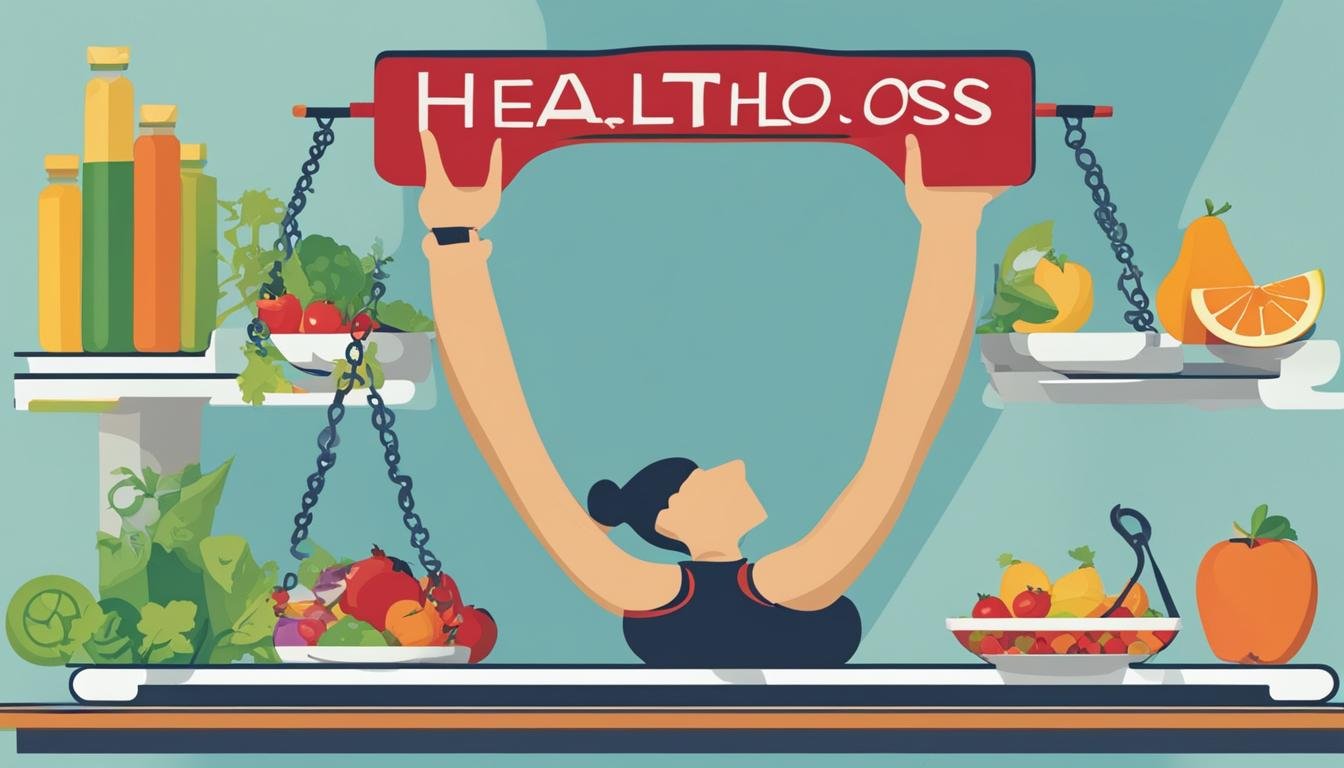As we age, balancing health and weight loss becomes increasingly challenging. Finding a sustainable approach that considers both our physical well-being and weight goals is essential. In this article, we will explore effective strategies for maintaining good health while shedding pounds after the age of 40.
Key Takeaways:
- Find a sustainable approach to health and weight loss after 40
- Consider both physical well-being and weight goals
- Explore effective strategies for maintaining good health
- Discover tips for successful weight management
- Understand the importance of a healthy lifestyle after 40
Understanding the Weight Loss Plateau
A weight loss plateau is a common occurrence when trying to lose weight. It is a point where your weight loss slows down or stops completely, despite your efforts to maintain a healthy lifestyle. This happens because your metabolism adjusts to the decreased calorie intake and activity level. Understanding the reasons behind a weight loss plateau and strategies to overcome it is essential for successful weight management.
There are several factors that can contribute to a weight loss plateau. One possible reason is that your body has reached its set point, which is the weight at which it feels comfortable and resists further weight loss. Other reasons include a decrease in muscle mass, hormonal changes, and a decrease in physical activity.
To overcome a weight loss plateau, it’s important to make changes to your approach. One strategy is to shake up your exercise routine by incorporating high-intensity interval training (HIIT) or strength training exercises. These types of exercises can increase your metabolism and help you break through the plateau. Additionally, reassessing your calorie intake and adjusting your diet can also have a positive impact. Making small changes, such as reducing portion sizes or eliminating high-calorie snacks, can make a big difference.
Strategies for Overcoming a Weight Loss Plateau:
- Change up your exercise routine with HIIT or strength training
- Reassess your calorie intake and make adjustments
- Focus on portion control and eliminate high-calorie snacks
- Stay consistent with your healthy habits and be patient
Remember, weight loss plateaus are normal and can be overcome with perseverance and the right strategies. By understanding the reasons behind a plateau and implementing effective methods to break through it, you can continue on your weight loss journey and achieve your goals.
| Reasons for Weight Loss Plateau | Strategies to Overcome Weight Loss Plateau |
|---|---|
| Metabolic adjustment to decreased calorie intake and activity level | Change up your exercise routine with HIIT or strength training |
| Reached body’s set point | Reassess your calorie intake and make adjustments |
| Decrease in muscle mass | Focus on portion control and eliminate high-calorie snacks |
| Hormonal changes | Stay consistent with your healthy habits and be patient |
Tips for Breaking Through a Weight Loss Plateau
Breaking through a weight loss plateau can be frustrating, but with the right strategies, you can overcome this hurdle and continue making progress towards your weight loss goals. Here are some tips to help you break through the plateau:
- Adjust your diet: Take a closer look at your current eating habits and make adjustments as needed. Consider reducing your calorie intake by choosing nutrient-dense foods that are lower in calories but still satisfying. Incorporate more vegetables, lean proteins, and whole grains into your meals to support your weight loss efforts.
- Increase physical activity: If you’ve hit a plateau, it may be time to step up your exercise routine. Incorporate different types of exercises, including cardiovascular activities and strength training, to challenge your body and boost your metabolism. Aim for at least 150 minutes of moderate-intensity exercise or 75 minutes of vigorous-intensity exercise each week.
- Try new workouts: Sometimes, our bodies adapt to the same workout routine, leading to a weight loss plateau. Shake things up by trying new workouts or exercise classes. This can help engage different muscle groups and keep your body guessing, ultimately leading to more effective weight loss.
- Manage stress: Stress can impact our bodies in various ways, including weight loss. Chronic stress can lead to hormonal imbalances that affect our metabolism and hinder weight loss progress. Engage in stress-management techniques like mindfulness meditation, deep breathing exercises, or yoga to help support your weight loss journey.
By implementing these tips, you can overcome a weight loss plateau and continue making progress towards your goals. Remember to be patient and consistent with your efforts, as breaking through a plateau may take time. Stay focused, stay motivated, and you’ll soon see the results you desire.
Quotes:
“Breaking through a weight loss plateau requires making changes to your approach. By adjusting your diet, increasing physical activity, and managing stress, you can jumpstart your weight loss again and continue moving towards your goals.” – Fitness Expert
The Role of Diet in Weight Loss After 40
When it comes to weight loss after the age of 40, maintaining a healthy diet is crucial. A balanced diet not only supports your weight loss goals but also promotes overall health and well-being. Here are some diet tips to help you achieve successful weight loss after 40:
Incorporate Nutrient-Dense Foods
Focusing on consuming nutrient-dense foods is key to achieving weight loss after 40. These foods provide essential vitamins, minerals, and macronutrients while being low in calories. Include lean proteins, such as chicken, fish, and tofu, as well as whole grains, like quinoa and brown rice, in your meals. Load up on fruits and vegetables, which are rich in fiber and antioxidants. Don’t forget to include healthy fats, such as avocados and nuts, to provide necessary energy and support satiety.
Practice Mindful Eating
Mindful eating involves paying attention to your body’s hunger and fullness cues, as well as being present in the moment while eating. Slow down and savor each bite, taking time to appreciate the flavors and textures of your food. This can help prevent overeating and promote a healthier relationship with food. Avoid distractions like screens and focus on the nourishment your meals provide.
Stay Consistent and Committed
Consistency is key when it comes to achieving and maintaining weight loss after 40. Stick to your healthy eating plan, even on weekends or special occasions. Make it a habit to plan and prepare your meals in advance, so you always have nutritious options readily available. Remember that sustainable weight loss takes time and commitment, so stay focused on your goals and celebrate your progress along the way.
By following these diet tips, you can create a solid foundation for weight loss after 40. Remember to consult with a healthcare professional or registered dietitian for personalized advice and guidance tailored to your specific needs and circumstances.
Exercise Routines for Middle-Aged Adults
Regular physical activity is vital for middle-aged adults looking to maintain a healthy weight and overall well-being. Incorporating a mix of cardiovascular exercises and strength training into your routine can help boost metabolism, increase muscle mass, and burn calories effectively. Finding exercises that you enjoy and can sustain long-term is the key to staying active and achieving your weight loss goals.
When it comes to cardiovascular exercises, activities like brisk walking, jogging, cycling, and swimming are excellent choices. Aim for at least 150 minutes of moderate-intensity aerobic exercise per week, or 75 minutes of vigorous-intensity activity if you’re up for the challenge. Remember to start at a comfortable pace and gradually increase intensity to avoid injury and overexertion.
In addition to cardiovascular exercises, incorporating strength training into your routine is essential for building lean muscle mass. This can be achieved through activities such as weight lifting, resistance band exercises, and bodyweight exercises like push-ups and squats. Strength training helps boost metabolism, improve bone density, and enhance overall strength and stability.
Sample Exercise Routine:
- Monday: 30 minutes of brisk walking or jogging + full body strength training (exercises targeting major muscle groups like squats, lunges, push-ups, and overhead presses).
- Tuesday: Rest day or low-impact activities like yoga or stretching.
- Wednesday: 30 minutes of cycling or swimming + core exercises (planks, Russian twists, and bicycle crunches).
- Thursday: 30 minutes of high-intensity interval training (HIIT) or circuit training + lower body strength training (exercises like deadlifts, step-ups, and glute bridges).
- Friday: Rest day or light activities like walking or gardening.
- Saturday: 30 minutes of moderate-intensity aerobic exercise (choose an activity you enjoy) + upper body strength training (exercises like bicep curls, tricep dips, and bent-over rows).
- Sunday: Rest day or active recovery activities like gentle stretching or a leisurely bike ride.
Remember to listen to your body and modify exercises as needed. It’s important to consult with a healthcare professional or certified fitness trainer before starting any exercise program, especially if you have any underlying health conditions or concerns.
| Benefits of Exercise for Middle-Aged Adults: | Recommended Frequency: |
|---|---|
| Increases metabolism and calorie burn | At least 150 minutes of moderate-intensity aerobic activity per week |
| Builds lean muscle mass | Strength training for major muscle groups 2-3 times per week |
| Improves cardiovascular health | Aim for 30 minutes of cardiovascular exercise most days of the week |
| Enhances strength and stability | Include strength training exercises targeting all major muscle groups |
Importance of Portion Control
When it comes to weight loss after 40, portion control plays a vital role in achieving your goals. Controlling your portion sizes helps prevent overeating, allows you to enjoy a variety of foods, and promotes healthier eating habits. By being mindful of the quantity of food you consume, you can create a calorie deficit and support your weight loss efforts.
One effective strategy for portion control is to use smaller plates and bowls. Research has shown that people tend to eat less when they are served smaller portions on smaller plates, as it tricks the brain into perceiving a larger meal. Additionally, measuring your portions using measuring cups or a food scale can provide a more accurate representation of serving sizes.
Being aware of your body’s hunger cues is another essential aspect of portion control. Take the time to listen to your body and eat until you feel satisfied, rather than eating until you are uncomfortably full. It’s important to remember that portion control is not about deprivation but rather about making mindful choices and finding the right balance that works for you.
Tips for Portion Control:
- Use smaller plates and bowls to visually create the illusion of a larger portion.
- Measure your portions using measuring cups or a food scale.
- Pay attention to your body’s hunger cues and eat until you feel satisfied.
- Fill half of your plate with vegetables to ensure a nutrient-dense meal.
- Avoid eating directly from the container, as it can lead to mindless overeating.
By incorporating portion control into your daily routine, you can enjoy a wide range of foods while still making progress towards your weight loss goals. Remember, it’s all about finding the right balance and creating sustainable habits for long-term success.
| Food | Recommended Portion Size |
|---|---|
| Protein (chicken, fish, tofu) | 3-4 ounces (about the size of a deck of cards) |
| Grains (rice, pasta, bread) | 1/2 cup cooked (about the size of a tennis ball) |
| Fruits | 1 medium piece or 1/2 cup |
| Vegetables | 1 cup raw or 1/2 cup cooked |
| Dairy (yogurt, milk) | 1 cup or 1-1.5 ounces of cheese |
| Fats (nuts, avocado, oils) | 1 tablespoon or 1/4 cup nuts |
Staying Hydrated for Weight Loss
When it comes to weight loss, one often overlooked factor is the importance of proper hydration. Drinking an adequate amount of water throughout the day can play a crucial role in promoting weight loss and overall health. Research has shown that staying hydrated can help curb appetite, boost metabolism, and enhance the body’s ability to burn calories.
Water acts as a natural appetite suppressant, helping you feel fuller and reducing the likelihood of overeating. In fact, a study published in the journal Obesity found that drinking water before meals can lead to reduced calorie intake and increased weight loss. Additionally, staying hydrated can help prevent water retention, which can make you feel bloated and contribute to temporary weight gain.
How much water should you drink?
The amount of water you need to drink each day varies depending on factors such as your weight, activity level, and climate. As a general guideline, the Institute of Medicine recommends drinking at least eight cups (64 ounces) of water per day. However, individual needs may differ, so it’s important to listen to your body and adjust your intake accordingly. If you’re physically active or live in a hot climate, you may need to consume more water to stay properly hydrated.
It’s also worth noting that water is the best choice for hydration when trying to lose weight. Sugary beverages such as soda, juice, and sports drinks can be high in calories and can contribute to weight gain. By replacing these drinks with water, you can reduce your calorie intake and support your weight loss efforts.
| Benefits of Staying Hydrated for Weight Loss | Ways to Stay Hydrated |
|---|---|
|
|
In conclusion, staying hydrated is a simple yet effective strategy for weight loss after the age of 40. By prioritizing water intake, you can support your body’s natural processes, promote proper digestion, and reduce the chances of overeating. Remember to listen to your body’s thirst signals and make water your beverage of choice for optimal hydration and weight management.
Building a Healthy Meal Plan
When it comes to weight loss after 40, building a healthy meal plan is essential for success. By focusing on a balanced diet that includes nutrient-dense foods, you can nourish your body while promoting weight loss. Here are some key tips for creating a meal plan that supports your goals:
- Eat a variety of fruits and vegetables: Incorporate a colorful array of fruits and vegetables into your meals. These provide essential vitamins, minerals, and antioxidants while being low in calories.
- Include lean proteins: Opt for lean sources of protein such as chicken, fish, tofu, or legumes. Protein helps keep you feeling full and satisfied, while supporting muscle growth and repair.
- Incorporate whole grains: Choose whole grains like brown rice, quinoa, and whole wheat bread. These are rich in fiber, which aids digestion and helps regulate blood sugar levels.
- Include healthy fats: Don’t shy away from healthy fats like avocado, nuts, and olive oil. These provide essential fatty acids and can help you feel satisfied between meals.
A well-rounded meal plan should also consider portion sizes and meal frequency. Aim for balanced meals that include a mix of proteins, carbohydrates, and fats. Additionally, spacing out your meals throughout the day can help regulate blood sugar levels and prevent overeating.
Sample Meal Plan
Here’s an example of a one-day meal plan that incorporates these principles:
| Meal | Food Choices |
|---|---|
| Breakfast | Scrambled eggs with spinach, whole wheat toast, and a side of berries |
| Snack | Greek yogurt with a sprinkle of granola and sliced almonds |
| Lunch | Grilled chicken breast with quinoa, roasted vegetables, and a mixed green salad |
| Snack | Carrot sticks with hummus |
| Dinner | Baked salmon with brown rice, steamed broccoli, and a side of avocado |
| Snack | Apple slices with almond butter |
Remember, this is just one example, and your meal plan should be tailored to your individual needs and preferences. Consulting with a registered dietitian can provide personalized guidance and support in creating a meal plan that works best for you.
Avoiding Alcohol and Limiting Treats
When it comes to weight loss after the age of 40, it’s important to pay attention to your alcohol consumption and treat intake. While enjoying an occasional drink or indulging in your favorite treats can be a part of a balanced lifestyle, moderation is key. Alcohol can be high in calories and can also lower inhibitions, leading to overeating or making less healthy food choices. By being mindful of your alcohol intake and practicing moderation, you can still enjoy social gatherings while keeping your weight loss goals on track.
“Moderation in all things” – a phrase that holds true when it comes to weight loss after 40.
Instead of completely depriving yourself of treats, find healthier alternatives that satisfy your cravings without sabotaging your progress. For example, opt for a piece of dark chocolate instead of a high-sugar dessert, or enjoy a small serving of frozen yogurt instead of a full ice cream sundae. By making small swaps and practicing portion control, you can still indulge in treats while staying mindful of your overall calorie intake.
Benefits of Limiting Alcohol and Moderating Treats
Limiting alcohol and moderating treats can have several benefits for your weight loss journey. Not only can it help reduce the number of empty calories you consume, but it can also help you develop healthier habits and improve your overall well-being. By reducing your alcohol intake, you may experience improved sleep quality, better liver function, and increased energy levels. Additionally, moderating your treats can help you develop a healthier relationship with food and decrease feelings of guilt or deprivation.
| Benefits of Avoiding Alcohol and Limiting Treats |
|---|
| Reduced calorie intake |
| Improved sleep quality |
| Better liver function |
| Increased energy levels |
| Healthier relationship with food |
| Decreased feelings of guilt or deprivation |
In conclusion, while it’s important to enjoy life and not completely restrict yourself, avoiding excess alcohol and moderating treats are crucial for successful weight loss after the age of 40. By practicing moderation and making healthier choices, you can continue to enjoy social occasions and satisfy your cravings while still achieving your weight loss goals and improving your overall health.
Understanding Emotional Eating
Emotional eating is a common phenomenon that can impede weight loss efforts and hinder our overall well-being. It refers to the act of using food as a coping mechanism to deal with emotional distress, such as stress, sadness, boredom, or anxiety. Many of us may find comfort in turning to our favorite foods during times of emotional turmoil, but it often leads to mindless eating and an unhealthy relationship with food.
Mindful eating is an effective strategy for combatting emotional eating and promoting weight loss. It involves paying attention to our body’s hunger cues, eating slowly, and savoring each bite. By being fully present and engaged with our meals, we can better tune in to our body’s signals of hunger and fullness, helping us make more informed decisions about what and how much to eat.
Practicing mindfulness in our daily lives can also help us build resilience and find healthier ways to cope with emotions. Engaging in activities such as deep breathing, meditation, or pursuing hobbies that bring us joy can provide alternative outlets for managing stress and emotional well-being. By developing mindful eating habits and cultivating emotional awareness, we can break free from the cycle of emotional eating and work towards our weight loss goals.
Conclusion
As we reach the age of 40 and beyond, maintaining weight loss becomes an ongoing journey towards long-term weight management. It requires a holistic approach that focuses not just on shedding pounds but also on prioritizing our overall health and well-being. By following a few key strategies, we can sustain our weight loss achievements and enjoy a healthier future.
First and foremost, it’s crucial to adopt healthy eating habits that provide the necessary nutrients while promoting weight loss. Incorporating a balanced diet rich in lean proteins, whole grains, fruits, vegetables, and healthy fats ensures that our bodies receive the fuel they need. By being mindful of portion control and building a structured meal plan, we can stay on track and achieve our weight loss goals.
In addition to a healthy diet, regular exercise is essential for maintaining weight loss after 40. Incorporating both cardiovascular exercises and strength training into our routines helps boost our metabolism, increase muscle mass, and burn calories. Finding activities we enjoy and can sustain long-term ensures that staying active becomes a lifelong habit.
Finally, staying hydrated is often overlooked but plays a crucial role in weight management. Drinking an adequate amount of water throughout the day helps curb appetite, prevent overeating, and support proper digestion. By making hydration a priority and replacing sugary beverages with water, we can further promote our weight loss efforts.
By implementing these strategies and adopting a balanced approach to weight loss and long-term weight management, we can achieve lasting results. It’s important to remember that this journey is unique for each individual, and what works for one may not work for another. Adjustments and modifications may be necessary along the way, but with perseverance and determination, we can maintain a healthy weight and live our best lives after 40.
FAQ
What is a weight loss plateau?
A weight loss plateau is a point where your weight loss slows down or stops completely, despite your efforts to maintain a healthy lifestyle.
Why do weight loss plateaus occur?
Weight loss plateaus occur because your metabolism adjusts to the decreased calorie intake and activity level, making it harder to continue losing weight.
How can I break through a weight loss plateau?
To break through a weight loss plateau, you can make changes to your approach by adjusting your diet, increasing physical activity, and making lifestyle modifications.
What should I focus on in my diet for weight loss after 40?
It’s important to focus on consuming nutrient-dense foods that provide necessary energy while promoting weight loss. This includes lean proteins, whole grains, fruits, vegetables, and healthy fats.
What type of exercise routines are best for middle-aged adults?
Incorporating both cardiovascular exercises and strength training into your routine can help boost your metabolism, increase muscle mass, and burn calories. Find exercises that you enjoy and can sustain long-term.
How can I practice portion control for weight loss?
Paying attention to the quantity of food you consume can help prevent overeating and promote weight loss. Use smaller plates, measure portions, and be mindful of your body’s hunger cues.
Why is staying hydrated important for weight loss?
Drinking an adequate amount of water can help curb appetite, prevent overeating, and promote proper digestion. Make it a habit to drink water throughout the day and replace sugary beverages with water.
How can I build a healthy meal plan?
Include a variety of nutritious foods, such as fruits, vegetables, lean proteins, and healthy fats, in your meal plan. Following a structured meal plan can help you stay on track and ensure you are getting the right balance of nutrients.
Should I avoid alcohol and treats for weight loss?
Limiting alcohol consumption and indulging in treats in moderation are crucial for weight loss after 40. Alcohol can be high in calories and affect your inhibitions, leading to overeating. Find healthier alternatives and practice moderation.
How can I break the cycle of emotional eating?
Understanding the triggers for emotional eating and finding alternative coping mechanisms, such as deep breathing or engaging in activities you enjoy, can help break the cycle of emotional eating and support successful weight loss.
How can I maintain weight loss after 40?
Achieving and maintaining weight loss after 40 requires a balanced approach that emphasizes overall health and well-being. Incorporate healthy eating habits, regular exercise, portion control, and staying hydrated for long-term weight management.






